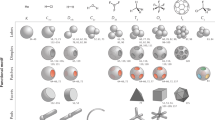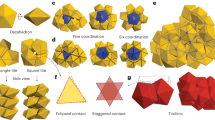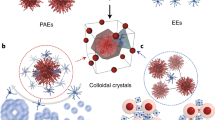Abstract
Self-assembling colloidal particles in the cubic diamond crystal structure could potentially be used to make materials with a photonic bandgap1,2,3. Such materials are beneficial because they suppress spontaneous emission of light1 and are valued for their applications as optical waveguides, filters and laser resonators4, for improving light-harvesting technologies5,6,7 and for other applications4,8. Cubic diamond is preferred for these applications over more easily self-assembled structures, such as face-centred-cubic structures9,10, because diamond has a much wider bandgap and is less sensitive to imperfections11,12. In addition, the bandgap in diamond crystals appears at a refractive index contrast of about 2, which means that a photonic bandgap could be achieved using known materials at optical frequencies; this does not seem to be possible for face-centred-cubic crystals3,13. However, self-assembly of colloidal diamond is challenging. Because particles in a diamond lattice are tetrahedrally coordinated, one approach has been to self-assemble spherical particles with tetrahedral sticky patches14,15,16. But this approach lacks a mechanism to ensure that the patchy spheres select the staggered orientation of tetrahedral bonds on nearest-neighbour particles, which is required for cubic diamond15,17. Here we show that by using partially compressed tetrahedral clusters with retracted sticky patches, colloidal cubic diamond can be self-assembled using patch–patch adhesion in combination with a steric interlock mechanism that selects the required staggered bond orientation. Photonic bandstructure calculations reveal that the resulting lattices (direct and inverse) have promising optical properties, including a wide and complete photonic bandgap. The colloidal particles in the self-assembled cubic diamond structure are highly constrained and mechanically stable, which makes it possible to dry the suspension and retain the diamond structure. This makes these structures suitable templates for forming high-dielectric-contrast photonic crystals with cubic diamond symmetry.
This is a preview of subscription content, access via your institution
Access options
Access Nature and 54 other Nature Portfolio journals
Get Nature+, our best-value online-access subscription
$29.99 / 30 days
cancel any time
Subscribe to this journal
Receive 51 print issues and online access
$199.00 per year
only $3.90 per issue
Buy this article
- Purchase on Springer Link
- Instant access to full article PDF
Prices may be subject to local taxes which are calculated during checkout




Similar content being viewed by others
Data availability
All data that support the findings are available from the corresponding authors on reasonable request.
References
Yablonovitch, E. Inhibited spontaneous emission in solid-state physics and electronics. Phys. Rev. Lett. 58, 2059–2062 (1987).
John, S. Strong localization of photons in certain disordered dielectric superlattices. Phys. Rev. Lett. 58, 2486–2489 (1987).
Ho, K. M., Chan, C. T. & Soukoulis, C. M. Existence of a photonic gap in periodic dielectric structures. Phys. Rev. Lett. 65, 3152–3155 (1990).
Joannopoulos, J. D., Johnson, S. G., Winn, J. N. & Meade, R. D. Photonic Crystals: Molding the Flow of Light 2nd edn (Princeton Univ. Press, 2008).
Halaoui, L. I., Abrams, N. M. & Mallouk, T. E. Increasing the conversion efficiency of dye-sensitized TiO2 photoelectrochemical cells by coupling to photonic crystals. J. Phys. Chem. B 109, 6334–6342 (2005).
Bermel, P., Luo, C., Zeng, L., Kimerling, L. C. & Joannopoulos, J. D. Improving thin-film crystalline silicon solar cell efficiencies with photonic crystals. Opt. Express 15, 16986–17000 (2007).
Zhang, Z., Zhang, L., Hedhili, M. N., Zhang, H. & Wang, P. Plasmonic gold nanocrystals coupled with photonic crystal seamlessly on TiO2 nanotube photoelectrodes for efficient visible light photoelectrochemical water splitting. Nano Lett. 13, 14–20 (2013).
Yanik, M. F., Fan, S., Soljacić, M. & Joannopoulos, J. D. All-optical transistor action with bistable switching in a photonic crystal cross-waveguide geometry. Opt. Lett. 28, 2506–2508 (2003).
Pusey, P. N. & van Megen, W. Phase behaviour of concentrated suspensions of nearly hard colloidal spheres. Nature 320, 340–342 (1986).
Vlasov, Y. A., Bo, X. Z., Sturm, J. C. & Norris, D. J. On-chip natural assembly of silicon photonic bandgap crystals. Nature 414, 289–293 (2001).
Sigalas, M. M., Soukoulis, C. M., Chan, C. T., Biswas, R. & Ho, K. M. Effect of disorder on photonic band gaps. Phys. Rev. B 59, 12767–12770 (1999).
Li, Z.-Y. & Zhang, Z.-Q. Fragility of photonic band gaps in inverse-opal photonic crystals. Phys. Rev. B 62, 1516–1519 (2000).
Busch, K. & John, S. Photonic band gap formation in certain self-organizing systems. Phys. Rev. E 58, 3896–3908 (1998).
Zhang, Z., Keys, A. S., Chen, T. & Glotzer, S. C. Self-assembly of patchy particles into diamond structures through molecular mimicry. Langmuir 21, 11547–11551 (2005).
Romano, F., Sanz, E. & Sciortino, F. Crystallization of tetrahedral patchy particles in silico. J. Chem. Phys. 134, 174502 (2011).
Wang, Y. et al. Colloids with valence and specific directional bonding. Nature 491, 51–55 (2012).
Noya, E. G., Zubieta, I., Pine, D. J. & Sciortino, F. Assembly of clathrates from tetrahedral patchy colloids with narrow patches. J. Chem. Phys. 151, 094502 (2019).
Manoharan, V. N., Elsesser, M. T. & Pine, D. J. Dense packing and symmetry in small clusters of microspheres. Science 301, 483–487 (2003).
Hynninen, A.-P., Thijssen, J. H. J., Vermolen, E. C. M., Dijkstra, M. & van Blaaderen, A. Self-assembly route for photonic crystals with a bandgap in the visible region. Nat. Mater. 6, 202–205 (2007).
Zanjani, M. B., Jenkins, I. C., Crocker, J. C. & Sinno, T. Colloidal cluster assembly into ordered superstructures via engineered directional binding. ACS Nano 10, 11280–11289 (2016).
Wang, Y., Jenkins, I. C., McGinley, J. T., Sinno, T. & Crocker, J. C. Colloidal crystals with diamond symmetry at optical lengthscales. Nat. Commun. 8, 14173 (2017).
Ducrot, É., He, M., Yi, G. R. & Pine, D. J. Colloidal alloys with preassembled clusters and spheres. Nat. Mater. 16, 652–657 (2017).
Liu, W. et al. Diamond family of nanoparticle superlattices. Science 351, 582–586 (2016).
Lin, H. et al. Clathrate colloidal crystals. Science 355, 931–935 (2017).
Romano, F. & Sciortino, F. Patterning symmetry in the rational design of colloidal crystals. Nat. Commun. 3, 975 (2012).
Damasceno, P. F., Engel, M. & Glotzer, S. C. Crystalline assemblies and densest packings of a family of truncated tetrahedra and the role of directional entropic forces. ACS Nano 6, 609–614 (2012).
Perro, A. et al. A chemical synthetic route towards “colloidal molecules”. Angew. Chem. Int. Ed. 48, 361–365 (2009).
Sacanna, S. & Pine, D. J. Shape-anisotropic colloids: building blocks for complex assemblies. Curr. Opin. Colloid Interface Sci. 16, 96–105 (2011).
Grünwald, M. & Geissler, P. L. Patterns without patches: hierarchical self-assembly of complex structures from simple building blocks. ACS Nano 8, 5891–5897 (2014).
McGinley, J. T., Wang, Y., Jenkins, I. C., Sinno, T. & Crocker, J. C. Crystal-templated colloidal clusters exhibit directional DNA interactions. ACS Nano 9, 10817–10825 (2015).
Ducrot, É., Gales, J., Yi, G.-R. & Pine, D. J. Pyrochlore lattice, self-assembly and photonic band gap optimizations. Opt. Express 26, 30052–30060 (2018).
Gong, Z., Hueckel, T., Yi, G. R. & Sacanna, S. Patchy particles made by colloidal fusion. Nature 550, 234–238 (2017).
Schade, N. B. et al. Tetrahedral colloidal clusters from random parking of bidisperse spheres. Phys. Rev. Lett. 110, 148303 (2013).
Wang, Z. et al. Active patchy colloids with shape-tunable dynamics. J. Am. Chem. Soc. 141, 14853–14863 (2019).
Agard, N. J., Prescher, J. A. & Bertozzi, C. R. A strain-promoted [3 + 2] azide-alkyne cycloaddition for covalent modification of biomolecules in living systems. J. Am. Chem. Soc. 126, 15046–15047 (2004).
Anderson, J. A., Lorenz, C. D. & Travesset, A. General purpose molecular dynamics simulations fully implemented on graphics processing units. J. Comput. Phys. 227, 5342–5359 (2008).
Glaser, J. et al. Strong scaling of general-purpose molecular dynamics simulations on GPUs. Comput. Phys. Commun. 192, 97–107 (2015).
Johnson, S. & Joannopoulos, J. Block-iterative frequency-domain methods for Maxwell’s equations in a planewave basis. Opt. Express 8, 173–190 (2001).
Lee, S., Zheng, C. Y., Bujold, K. E. & Mirkin, C. A. A cross-linking approach to stabilizing stimuli-responsive colloidal crystals engineered with DNA. J. Am. Chem. Soc. 141, 11827–11831 (2019).
Imhof, A. & Pine, D. J. Ordered macroporous materials by emulsion templating. Nature 389, 948–951 (1997).
Wijnhoven, J. E. G. J. & Vos, W. L. Preparation of photonic crystals made of air spheres in titania. Science 281, 802–804 (1998).
Holland, B. T., Blanford, C. F. & Stein, A. Synthesis of macroporous minerals with highly ordered three-dimensional arrays of spheroidal voids. Science 281, 538–540 (1998).
von Freymann, G. et al. Three-dimensional nanostructures for photonics. Adv. Funct. Mater. 20, 1038–1052 (2010).
Liu, L., Karuturi, S. K., Su, L. T. & Tok, A. I. Y. TiO2 inverse-opal electrode fabricated by atomic layer deposition for dye-sensitized solar cell applications. Energy Environ. Sci. 4, 209–215 (2011).
Gratson, G. M. et al. Direct-write assembly of three-dimensional photonic crystals: Conversion of polymer scaffolds to silicon hollow-woodpile structures. Adv. Mater. 18, 461–465 (2006).
van Blaaderen, A., Ruel, R. & Wiltzius, P. Template-directed colloidal crystallization. Nature 385, 321–324 (1997).
Leal-Calderon, F., Mondain-Monval, O., Pays, K., Royer, N. & Bibette, J. Water-in-oil emulsions: role of the solvent molecular size on droplet interactions. Langmuir 13, 7008–7011 (1997).
Chen, Q., Bae, S. C. & Granick, S. Directed self-assembly of a colloidal kagome lattice. Nature 469, 381–384 (2011).
Bonn, D. et al. Direct observation of colloidal aggregation by critical Casimir forces. Phys. Rev. Lett. 103, 156101 (2009).
van der Wel, C. et al. Preparation of colloidal organosilica spheres through spontaneous emulsification. Langmuir 33, 8174–8180 (2017).
Stukowski, A. Visualization and analysis of atomistic simulation data with OVITO–the open visualization tool. Model. Simul. Mater. Sci. Engin. 18, 015012 (2010).
Acknowledgements
This research was primarily supported by the US Army Research Office under award number W911NF-17-1-0328. Additional funding was provided by the National Science Foundation under award number DMR-1610788. G.-R.Y. acknowledges support from the NRF (South Korea) under award number 2017M3A7B8065528. We acknowledge the use of shared facilities provided through the Materials Research Science and Engineering Center (MRSEC) programme of the National Science Foundation under award number DMR-1420073. The computational work was supported in part through the NYU IT High Performance Computing resources, services and staff expertise.
Author information
Authors and Affiliations
Contributions
M.H. designed the synthetic protocol, synthesized and crystallized the patchy colloidal clusters, dried the crystals, and performed the optical and electron microscopy. M.H. and Z.G. synthesized the spherical patchy colloidal particles that led to the patchy colloidal cluster idea. É.D. performed the simulations and J.P.G. performed the photonic bandgap calculations that contributed to the design of the photonic crystals. D.J.P. and S.S. conceived the study and supervised the research, with the help of G.-R.Y. The manuscript was written by D.J.P., M.H. and J.P.G. All authors discussed the results and commented on the manuscript.
Corresponding authors
Ethics declarations
Competing interests
The authors declare no competing interests.
Additional information
Publisher’s note Springer Nature remains neutral with regard to jurisdictional claims in published maps and institutional affiliations.
Extended data figures and tables
Extended Data Fig. 1 Controlling compression and size ratios.
a–c, The compression ratio of clusters can be changed by adding differing amounts of THF in the deformation step: a, no THF; b, 18 vol% THF; c, 30 vol% THF. d–f, The size ratio can be controlled by using different surfactants in the polymerization step: d, 0.05 wt% F-127; e, 0.05 wt% F-127 + 0.05 wt% SDS; f, 0.05 wt% F-127 + 0.05 wt% Triton X-100. Scale bars, 1 μm.
Extended Data Fig. 2 Fluorescent microscope image of DNA-coated compressed tetrahedral clusters.
DNA strands are fluorescently labelled. The image shows that the single-stranded DNA can be selectively functionalized onto the TPM patches and that the polystyrene surfaces are nearly bare. Note that the polystyrene surfaces need not be completely bare of DNA strands: the areal coverage of DNA just has to be much lower on the polystyrene surfaces than on the TPM patches, so that the DNA melting temperatures for the sphere–patch or sphere–sphere interactions are lower than for the patch–patch interaction. The melting temperatures for the polystyrene–polystyrene and polystyrene–TPM interactions are always 6–20 °C below that of the TPM–TPM interaction. Inset, illustration of DNA-coated compressed clusters: red, DNA-coated TPM patches; white, polystyrene spheres not coated with DNA. Scale bar, 5 μm.
Extended Data Fig. 3 Self-assembly of DNA-coated compressed clusters.
a, Simulation data (diamond symbols) are obtained using the HOOMD-blue software package; experimental data (circles) are superimposed. A typical simulation run is performed with 216–8,000 particles in a box with periodic boundaries at a volume fraction of 5%. The system is slowly cooled in the vicinity of the aggregation temperature. The final system is analysed to detect and characterize the formation of a potential crystalline phase. The red diamonds represent where the particles crystallize into cubic diamond; the grey diamonds represents where the system condenses into amorphous structures. The attractive DNA interaction is modelled by a Lennard–Jones potential that has its minimum at 1.03b. Using a shorter-range attractive potential between patches moves the region where cubic diamond crystals form to larger size ratios; a longer-range potential does the opposite. The grey line shows the locus of size and compression ratios where all three spherical lobes and the patch on neighbouring particles simultaneously touch in the staggered conformation. The blue circles represent experimental samples that either crystallized in the cubic diamond structure (closed circles; error bars ±0.02 in both directions) or formed random aggregates (open circles; similar uncertainties but with the error bars suppressed). b, A snapshot of the simulated system where the compressed clusters crystallized into cubic diamond crystals (dcc/(2a) = 0.70).
Extended Data Fig. 4 Self-assembly of DNA-coated compressed clusters.
a–d, Optical microscope bright-field images of two-particle (a) and four-particle (b) aggregates, the 110 plane of a small crystal (c) and the 111 plane of the crystal (d). e–h, Corresponding computer-generated images. Scale bars, 1 μm.
Extended Data Fig. 5 Inverse cubic diamond lattice of clusters.
a, Structure for a compression ratio of 0.76. The size ratio is chosen so that patches just touch. The volume fraction of solid material is 0.32. b, Same as in a, but made using a protective oxide layer with a thickness of 10% of the radius of the spherical lobe of a cluster. The volume fraction of solid material is 0.20. c, Band diagram for an inverse diamond lattice of clusters with a compression ratio of 0.76 (the structure shown in a), showing a complete photonic bandgap with a relative width of 0.12 between the second and third bands (highlighted in blue). The vertical axis is the dimensionless frequency fa/c, where f is frequency, a is lattice constant and c is the speed of light in vacuum. Only the first five bands are shown, but the first 50 were calculated and no other bandgaps were found. d, Minimum index nmin at which a bandgap opens for a range of compression ratios: direct lattice, blue; inverse lattice, red.
Supplementary information
Video 1
Illustration of the free rotation of a single bond between patchy particles. For spherical patchy particles, there is no preferred conformation: the staggered conformation, eclipsed conformation, and all the conformations in between are equally likely. Moreover, the bond angle between patchy particles is flexible, which makes the formation of four-, five-, six-, and seven-membered rings possible.
Video 2
Unit cell of a direct lattice of colloidal cubic diamond of compressed clusters.
Video 3
Confocal microscope z-stack taken along the 110 plane of colloidal diamond crystals. The TPM is fluorescently labelled. The z-stack step size is 500 nm.
Video 4
Confocal microscope z-stack taken along the 111 plane of colloidal diamond crystals. The TPM is fluorescently labeled. The z-stack step size is 500 nm.
Video 5
A unit cell of the inverse lattice of colloidal diamond by compressed clusters. The compression ratio is 0.74.
Rights and permissions
About this article
Cite this article
He, M., Gales, J.P., Ducrot, É. et al. Colloidal diamond. Nature 585, 524–529 (2020). https://doi.org/10.1038/s41586-020-2718-6
Received:
Accepted:
Published:
Issue Date:
DOI: https://doi.org/10.1038/s41586-020-2718-6
This article is cited by
-
Direct observation of phase transitions in truncated tetrahedral microparticles under quasi-2D confinement
Nature Communications (2024)
-
Macroscopic photonic single crystals via seeded growth of DNA-coated colloids
Nature Communications (2023)
-
Clustering of charged colloidal particles in the microgravity environment of space
npj Microgravity (2023)
-
A colloidal viewpoint on the sausage catastrophe and the finite sphere packing problem
Nature Communications (2023)
-
Visualizing defect dynamics by assembling the colloidal graphene lattice
Nature Communications (2023)
Comments
By submitting a comment you agree to abide by our Terms and Community Guidelines. If you find something abusive or that does not comply with our terms or guidelines please flag it as inappropriate.



